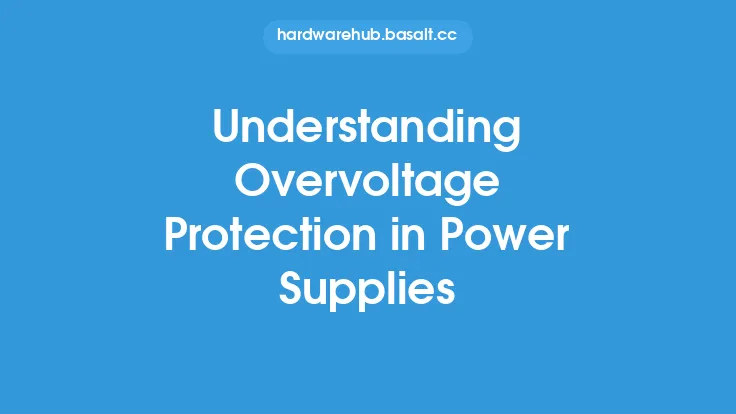Power supplies are a crucial component in many electronic devices, providing the necessary voltage and current to ensure proper operation. However, they can be susceptible to various types of faults, including short circuits, which can cause damage to the power supply and other components in the system. To mitigate this risk, power supplies often incorporate short circuit protection, a critical feature that helps prevent damage and ensure safe operation.
Introduction to Short Circuit Protection
Short circuit protection is a mechanism designed to detect and respond to short circuit conditions in a power supply. A short circuit occurs when there is an unintended path of electricity with little to no resistance, causing an excessive amount of current to flow. This can happen due to various reasons, such as a fault in the load, a wiring issue, or a component failure. When a short circuit is detected, the protection mechanism kicks in, disconnecting the power supply from the load or reducing the output voltage and current to a safe level.
Types of Short Circuit Protection
There are several types of short circuit protection used in power supplies, each with its own strengths and weaknesses. Some common types include:
- Fuses: Fuses are a simple and inexpensive way to provide short circuit protection. They work by melting a metal element when the current exceeds a certain threshold, breaking the circuit and disconnecting the power supply from the load.
- Circuit Breakers: Circuit breakers are similar to fuses but can be reset after a fault has been cleared. They are often used in applications where the power supply needs to be restarted quickly after a fault.
- Current Limiting: Current limiting is a technique used to reduce the output current of the power supply when a short circuit is detected. This helps prevent damage to the power supply and other components in the system.
- Foldback Current Limiting: Foldback current limiting is a variation of current limiting that reduces the output current to a very low level when a short circuit is detected. This helps prevent damage to the power supply and other components in the system.
How Short Circuit Protection Works
Short circuit protection works by monitoring the output current of the power supply and detecting when it exceeds a certain threshold. When a short circuit is detected, the protection mechanism kicks in, disconnecting the power supply from the load or reducing the output voltage and current to a safe level. The specific implementation of short circuit protection can vary depending on the type of power supply and the application. In general, however, the process involves the following steps:
- Current Sensing: The power supply monitors the output current using a current sense resistor or other sensing mechanism.
- Comparison: The sensed current is compared to a threshold value, which is typically set to a level slightly above the normal operating current of the power supply.
- Detection: If the sensed current exceeds the threshold value, a short circuit is detected, and the protection mechanism is triggered.
- Response: The protection mechanism responds to the short circuit by disconnecting the power supply from the load or reducing the output voltage and current to a safe level.
Components Used in Short Circuit Protection
Several components are used to implement short circuit protection in power supplies, including:
- Current Sense Resistors: Current sense resistors are used to monitor the output current of the power supply. They are typically low-value resistors connected in series with the output of the power supply.
- Voltage Regulators: Voltage regulators are used to regulate the output voltage of the power supply and can also be used to implement short circuit protection.
- Power MOSFETs: Power MOSFETs are used to switch the output of the power supply on and off and can also be used to implement short circuit protection.
- Control ICs: Control ICs are used to monitor the output current and voltage of the power supply and can also be used to implement short circuit protection.
Benefits of Short Circuit Protection
Short circuit protection provides several benefits, including:
- Prevention of Damage: Short circuit protection helps prevent damage to the power supply and other components in the system by disconnecting the power supply from the load or reducing the output voltage and current to a safe level.
- Improved Safety: Short circuit protection improves safety by reducing the risk of electrical shock or fire.
- Increased Reliability: Short circuit protection increases reliability by reducing the risk of component failure due to short circuits.
- Reduced Downtime: Short circuit protection reduces downtime by allowing the power supply to be restarted quickly after a fault has been cleared.
Applications of Short Circuit Protection
Short circuit protection is used in a wide range of applications, including:
- Computer Power Supplies: Computer power supplies use short circuit protection to prevent damage to the power supply and other components in the system.
- Industrial Power Supplies: Industrial power supplies use short circuit protection to prevent damage to the power supply and other components in the system.
- Medical Power Supplies: Medical power supplies use short circuit protection to prevent damage to the power supply and other components in the system and to ensure safe operation.
- Aerospace Power Supplies: Aerospace power supplies use short circuit protection to prevent damage to the power supply and other components in the system and to ensure safe operation.
Conclusion
In conclusion, short circuit protection is a critical feature in power supplies that helps prevent damage and ensure safe operation. It works by monitoring the output current of the power supply and detecting when it exceeds a certain threshold. When a short circuit is detected, the protection mechanism kicks in, disconnecting the power supply from the load or reducing the output voltage and current to a safe level. Short circuit protection provides several benefits, including prevention of damage, improved safety, increased reliability, and reduced downtime. It is used in a wide range of applications, including computer power supplies, industrial power supplies, medical power supplies, and aerospace power supplies.





